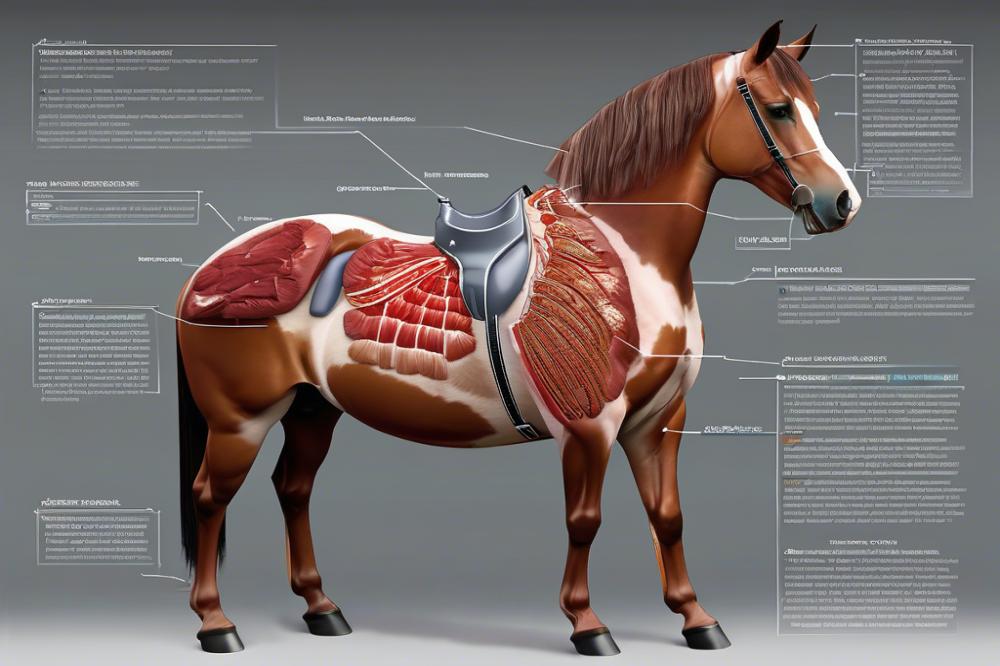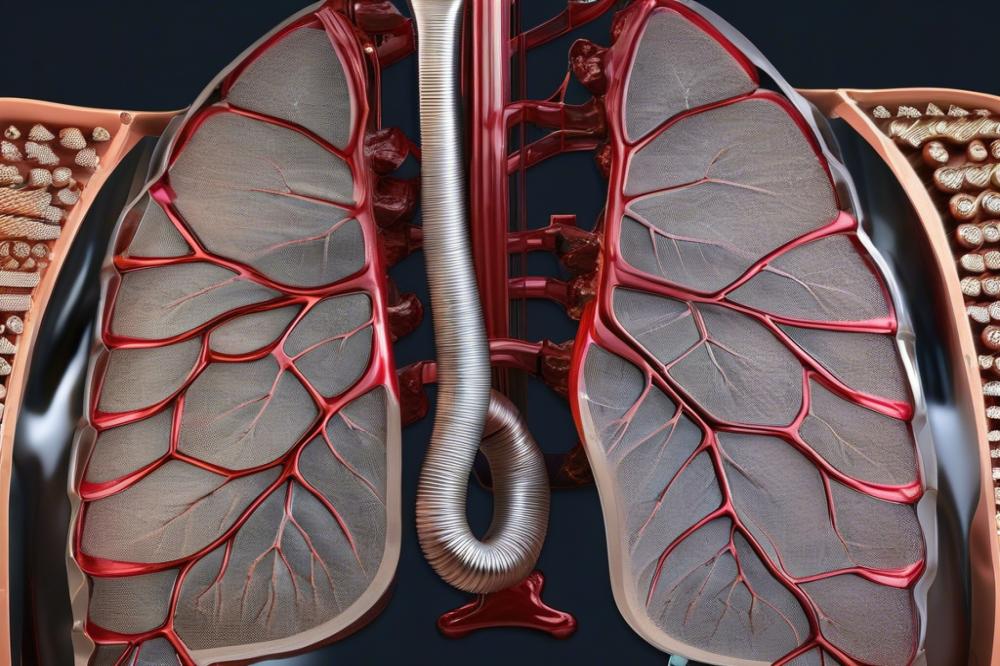Understanding the Role of Horse Lungs
Have you ever stopped to think about the vital role that horse lungs play in equine health? These remarkable organs are a crucial part of the respiratory system and perform a wondrous job of filtering oxygen into the bloodstream while kicking out carbon dioxide. Just like a well-oiled machine, the lungs work tirelessly. With each breath, they support everything from casual trail rides to thrilling races, where the competition can be as intense as a clash between a standardbred vs thoroughbred.
Equine anatomy reveals that the horse lungs are not just any regular set of lungs. They’re built to handle large volumes of air, thanks to their unique structure. These organs are divided into several lobes, allowing for efficient breathing and gas exchange. Picture a sponge soaking up water; in a similar way, the lungs absorb oxygen for the horse’s body to use, keeping it fit and strong. Proper horse care means recognizing that these systems need looking after just like any of the horse’s other vital components.
Think about it: just as you might tune up a car before a long trip, equine health relies on ensuring that the lungs are functioning properly. For instance, a budyonny horse, bred for endurance and performance, depends heavily on its respiratory capabilities during events. If the lungs are compromised due to illness, injury, or even environmental factors like dust or pollen, a horse’s performance can be affected significantly.
When it comes to exercise and performance, horse lungs are during the spotlight. They can affect a horse’s stamina and overall ability to excel in various activities. Poor lung function can be the difference between winning a race or finishing in the last stretch. So, equestrians and owners alike should pay attention to signs of trouble, like coughing or labored breathing.
In conclusion, understanding how horse lungs operate is vital for anyone involved in the equine world. Whether you are a casual rider or compete regularly, knowing about the adequate function and health of these lungs can help keep your horse in tip-top shape. After all, a happy, healthy horse is what we all aim for!
Anatomy of Horse Lungs

Understanding the structure of equine lungs can make a big difference in horse care and horse health. These lungs are a vital part of the respiratory system in horses. They work hard to provide oxygen, helping our equine friends perform their best. A horse’s lungs are quite different from those of humans or other animals. For starters, they’re larger and more efficient, which is crucial for a creature that can gallop and sprint.
Taking a closer look, the lungs are divided into lobes, which are like sections of a sponge. In horses, there are three primary lobes on the right side and two on the left. These lobes allow for tremendous surface area where gas exchange happens. You could say it’s like having multiple compartments to help absorb oxygen and release carbon dioxide effectively.
Now, let’s talk about bronchi and alveoli. The bronchi are tubes that branch out from the windpipe, guiding air into each lobe of the lungs. Imagine a tree with branches spreading out—each branch carries air to a different part of the lungs. When the air reaches the alveoli, which are tiny sacs at the end of those branches, the real magic happens. This is where oxygen and carbon dioxide swap places, allowing the horse to breathe in what it needs.
You might wonder how these lungs differ from others. Dogs, for instance, have a different lobe structure and an increased capacity for quick breaths. In contrast, horses have lungs designed for endurance, which is crucial when they’re running long distances. Their intricate system helps them maintain stamina, even in stressful situations.
If you ever observe a horse during exercise, notice how its sides expand and contract. This movement is essential for proper breathing. Good airflow is crucial for peak athletic performance. Regular check-ups can help monitor any issues with the lungs, ensuring they remain at top function.
Learning about this aspect of equine anatomy can be quite eye-opening. An informed horse owner can spot potential respiratory problems early on. From allergies to infections, many issues can arise. Paying attention to your horse’s breathing patterns can highlight underlying health concerns. Recognizing these signs can save lots of worry down the line.
Physiology of Horse Lungs

Have you ever wondered how horses breathe so effectively? The respiratory system of these magnificent animals plays a crucial role in their overall health and athletic performance. In essence, the horse lungs function like a powerful air pump, constantly taking in oxygen while expelling carbon dioxide. This process is vital for sustaining life and supporting all the activities horses engage in.
Gas Exchange Processes
When a horse inhales, air travels through their nostrils and into the lungs. There, it encounters alveoli, tiny air sacs that resemble little balloons. This is where the magic happens. Oxygen from the air passes through the walls of these sacs and enters the blood. In return, carbon dioxide, a waste product, moves from the blood into the alveoli to be exhaled. Think of it as a bustling market where oxygen comes in, and carbon dioxide steps out.
Oxygen Uptake and Carbon Dioxide Removal
The efficiency of this exchange is remarkable. The large surface area of the horse lungs is designed to maximize oxygen uptake. Just imagine a sponge soaking up water. That’s how the lungs absorb oxygen. They also remove carbon dioxide just as efficiently. This process isn’t just automatic; it’s essential for a horse’s energy levels and stamina. Proper horse care involves recognizing how critical this function is for horse health. Healthy lungs mean a healthy horse!
Influence of Exercise on Lung Function
Exercise certainly plays a significant role in how well a horse’s lungs perform. When a horse gallops, its breathing rate increases dramatically. This helps deliver more oxygen to the body and remove carbon dioxide quickly. You could say that a horse’s lungs get a workout, too! During rigorous activities, their capacity to breathe deeply becomes crucial. This is why training and conditioning are vital for athletes of equine anatomy.
Interestingly, horses can develop stronger lungs with regular exercise. Over time, their bodies adapt to become more efficient. This adaptation is like a runner improving their speed. With each gallop, horses build lung strength and capacity. So, the next time you see a horse racing or jumping, remember that their lungs are working overtime to keep them going!
In summary, understanding how a horse’s respiratory system operates is more than just trivia; it’s an essential part of horse care. Ensuring that these magnificent creatures have healthy lungs not only impacts how they perform but also how they thrive in daily life. So, let’s all give a little cheer for those amazing lungs; they truly are the unsung heroes of a horse’s health!
Common Respiratory Conditions

When we talk about horse health, it’s hard to skip over respiratory issues. After all, those horse lungs do a lot of heavy lifting! Many common problems can pop up, affecting how these majestic creatures breathe and perform.
Heaves
One prevalent condition is heaves, which is sort of like asthma for horses. This problem can leave a horse coughing and wheezing. Dusty hay or moldy feed often triggers these symptoms. Owners need to watch closely for signs like a prolonged cough or difficulty breathing, especially during exercise. Treatment usually includes environmental changes, medications, and a good dose of TLC. More fresh air and an allergy test can make a difference!
Bronchitis
Now, let’s chat about bronchitis. It can also cause coughing and discharge from the nose. Often, this condition arises after a horse has a cold or another infection. Inflammation of the airways results in discomfort. A veterinarian may listen to the horse’s chest to diagnose the issue. Treatments can involve anti-inflammatory drugs and possibly antibiotics if a bacterial infection is present. Regular check-ups help keep an eye on the breathing.
Pneumonia
Pneumonia sounds serious, and it can be! This infection affects the lungs directly and can make any horse feel unwell. Keep an eye out for a fever, rapid breathing, or a loss of appetite. Horses can be a bit tough to read sometimes, especially if they’re stubborn. Your horse should be examined by a vet quickly. They might suggest X-rays or blood tests to see what’s happening inside. Antibiotics are often necessary to fight back against pneumonia.
Managing Respiratory Health
Healthy air quality can greatly improve a horse’s respiratory system. Good horse care involves making sure stables are clean and well-ventilated. What you feed also plays a role! Fresh, mold-free hay and grain keep respiratory concerns at bay. Monitoring a horse’s breathing and overall health should be part of daily routines. If a horse shows signs of struggling to breathe, act fast! The quicker you catch a problem, the better chance you have of treating it successfully.
All these conditions highlight the importance of understanding equine anatomy. Knowing how a horse breathes can aid in noticing when something isn’t right. Dedication to horse health means paying attention to their behavior, environment, and any changes in their breathing patterns. If you combine awareness with proactive care, your horse can live a happy, healthy life.
Impact of Environment on Horse Lungs
When it comes to keeping a horse healthy, the environment plays a big role. Air quality is crucial for the respiratory system. Horses are out in the world, breathing in air that can be full of allergens and pollutants. Think about it: just like us, equines need clean air to thrive.
Stable management also affects lung health. Poorly managed stables can turn into dust bowls. That dust can stir up a storm of respiratory issues. Keeping a clean and dry stable helps reduce those risks. Regularly changing bedding and minimizing mold can go a long way.
Outdoor conditions matter too. Horses that spend time outside can get exposed to a range of natural irritants. Pollen from plants, dust from dirt roads, and even smoke from nearby fires can be harmful. It’s essential for caretakers to monitor these factors, especially during certain seasons.
Allergens can sneak up on you. Some horses are more sensitive than others. If a horse starts coughing or showing signs of distress, it might be time to check the environment. Noticing these signs early on can help in managing their health effectively.
Another important factor is ventilation. A well-ventilated barn helps fresh air circulate. Stagnant air can trap harmful particles and worsen the situation. Just imagine trying to breathe in a stuffy room—no fun for anyone!
Horse care isn’t just about feeding and grooming. It also means being aware of what’s around them. Making small changes in their environment can lead to big improvements in their health. Good stable management practices are key to ensuring that these magnificent creatures can breathe easy.
In the end, protecting equine anatomy, especially the lungs, involves a bit of diligence. Keeping an eye on air quality and managing allergens can help prevent serious respiratory problems. After all, a happy horse means a happy owner!
Training and Performance Considerations
When it comes to athletic performance, lung capacity and overall health play a big role. A horse’s ability to take in air directly affects their stamina. If their respiratory system struggles, it can limit how hard they can work. Think of it like a car running out of gas before reaching the finish line. No matter how fast the horse is, if the lungs aren’t up to snuff, they won’t perform their best.
Conditioning is vital for any competitive horse. You wouldn’t expect an Olympic athlete to run a marathon without training, right? Horses need to build strength and endurance over time, too. Regular workouts help develop their lung capacity. Gradual increases in exercise teach their body to work more efficiently. This is similar to teaching a kid to ride a bike. They start small and build up their confidence and skill.
Breathing techniques can also make a difference. When a horse learns to control their breathing, it becomes easier to manage exertion. Slow, deep breaths can help maximize oxygen intake. Think of it like blowing up a balloon. The more air you get in, the bigger it gets! Proper techniques can also calm nerves during competitions. A relaxed horse performs much better than a stressed one.
Monitoring lung health should be part of every horse care routine. Regular check-ups can catch problems before they become serious. After all, an ounce of prevention is worth a pound of cure. Pay attention to any signs of distress, like coughing or labored breathing. These can indicate issues brewing in the respiratory system. Keeping horses healthy involves being proactive, not reactive.
Utilizing tools like a stethoscope during workouts can give insights into lung function. Just like a human athlete can benefit from a heart rate monitor, horses can too! Recognizing when their lungs are working harder can help trainers adjust workouts as needed. You wouldn’t want to overexert a horse in training, just as you wouldn’t push a friend beyond their limits.
Ultimately, understanding equine anatomy is the key. The lungs are remarkable organs. They support not just breathing but overall performance. Truly, a healthy respiratory system is like a solid foundation for a house. With good care and attention, your horse can reach new heights in their athletic pursuits.
Preventive Measures and Care
Maintaining healthy lungs in horses is important. Care for these majestic animals goes beyond just food and exercise. A little attention can go a long way. Regular veterinary check-ups are essential. Imagine your horse as an athlete; they need their coach to spot issues before they become real problems. Routine exams help catch any respiratory troubles early on.
Vaccinations are another important part of horse health. They protect against diseases that might weaken the respiratory system. A horse without vaccinations is like a ship without a sail—it can easily drift into trouble. Consult your vet about the best vaccination schedule. Knowledge is power, after all.
Air quality in your horse’s environment plays a huge role in lung health. Dust, mold, and pollen can set off issues. Keeping stalls clean is key. Think of it like spring cleaning; everyone feels better in a tidy space! Good ventilation is also vital. Horses need fresh air, just like a teenager needs to escape their room now and then.
Horse care also includes managing stress. A calm horse is a happy horse, and a happy horse has better lungs. Regular exercise, companionship, and a routine can help keep your equine buddy at ease. It’s like when you have a bad day; being around friends can lift your spirits!
Proper nutrition supports overall health, including the respiratory system. A balanced diet rich in vitamins and minerals keeps everything in tune. When it comes to equine anatomy, a strong body leads to stronger lungs. Ah, the circle of life, right?
Lastly, be observant of your horse. If they start coughing or seem out of breath, something may be off. It’s better to be safe than sorry. Just like a parent knows when their child is not feeling well, you can tell when your horse needs help. Pay close attention; they can’t speak up when discomfort arises.
Wrapping Up: The Importance of Lung Health in Horses
When we consider equine health, it’s easy to get caught up in flashy things like shiny coats or perfect hooves. However, the lungs play an essential role that deserves our attention. They are the unsung heroes, quietly supplying the oxygen needed for those powerful gallops, graceful dressage movements, and everything in between. Just like a well-tuned engine in a fancy car, the lungs need to be in top shape for optimal performance.
Maintaining lung health is crucial for a horse’s overall well-being. Owners and caregivers should pay close attention to the environments horses are kept in. Dusty arenas or fields filled with moldy hay can be dangerous culprits. A clean, well-ventilated area can make all the difference. Just picture this: a horse soaring gracefully over a jump while wearing a dressage saddle vs jumping saddle. If their lungs aren’t healthy, that leap might not be as effortless.
Importantly, regular check-ups with a veterinarian can help catch any issues before they become major problems. Ensuring that horses receive adequate exercise, proper nutrition, and appropriate management can foster strong lungs, ready to tackle any challenge. It’s like taking care of your favorite sports equipment—you wouldn’t let a basketball sit in a dusty garage and expect it to bounce perfectly when the game begins!
Let’s not forget about the fun side of horses, either. In Greek mythology, they symbolize strength and elegance, often depicted running freely through the fields. We can carry that symbolism into our responsibility as horse owners. Just as those mythical steeds embodied grace, we should strive to keep our real-life companions healthy and vibrant.
In conclusion, taking the time to care for your horse’s respiratory health benefits their performance and contributes to their happiness. Treat those precious lungs with the care they deserve, and you’ll find that your horse not only runs faster but also enjoys every moment spent together.



